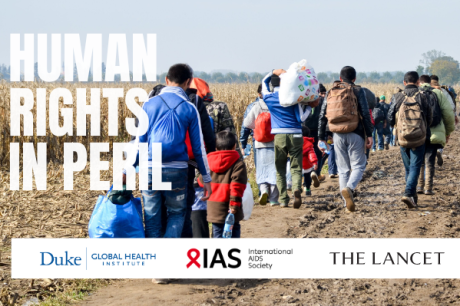
Children in Eldoret, Kenya. Photo credit: Jrh008, via Wikimedia Commons.
Published March 21, 2017, last updated on June 3, 2020 under Research News
In a first-of-its-kind study to look at the connection between child survival and the health system context, DGHI and Rice University researchers found that health care costs and the number and proximity of health facilities were major factors contributing to child survival in Kenya.
The study—co-authored by DGHI associate professor Wendy Prudhomme O’Meara, DGHI biostatistician Ryan Simmons and their Rice University colleague, Rebecca Anthopolos—was published in the March 14 edition of Scientific Reports.
Study Looked at 80,000+ Children
The DGHI colleagues examined large datasets from Kenya’s Demographic and Health Surveys to take a retrospective look at more than 80,000 children between one and five years old over a 17-year period.
Given that 50 percent of all childhood deaths occur in sub-Saharan Africa, this deep, detailed, country-specific analysis demonstrates the importance of health care services and attempts to redefine the notion of access.
“We were able to broaden the definition of ‘access’ to health facilities to include distance, quality and cost, and rank their relative importance on child mortality,” said O’Meara.
Financial Access Had the Greatest Impact
Fees related to acute care had the greatest impact on child survival. “These are emergency, urgent care situations that families don’t typically plan or save for,” said O’Meara. The study illuminated the increasing presence and importance of private sector health facilities in Kenya, which may have also been a factor in health care costs and broadened access, particularly in urban areas.
“More attention should be given to understanding the role of the private sector healthcare in Kenya,” said Prudhomme O’Meara. “It is clearly having an impact on health outcomes.”
Some Correlations Were Surprising
According to O’Meara, there are striking differences in child survival between regions, and it doesn’t correlate as closely with poverty as one might think. There are, she said, marked difference in health services indicators. For example, five times more facilities had a doctor in Nairobi than in the very poor, remote province of Northeastern. These two provinces represent the extremes in many of Kenya’s health services indicators.
O’Meara was surprised to find that the presence of a doctor was not correlated to child survival, which may point to the role of Kenya’s “clinical health officers” (COs) in health system capacity. COs are similar to physician assistants.
Overall, she is pleased with what they were able to glean from their analysis of the data because, she said, “measuring the impact of health systems readiness or infrastructure on morbidity and mortality is notoriously difficult.” She is hoping to use a similar approach in other countries in sub-Saharan Africa.
This study was funded through grants from the National Institutes of Health (NIH).


